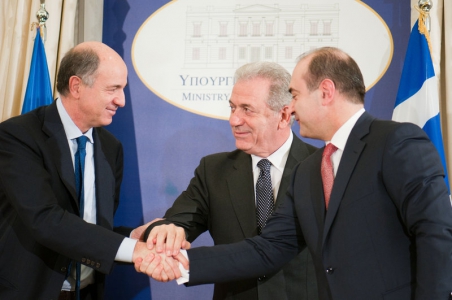
TAP Project Surging Ahead of Rival Nabucco-West (Part One)
Publication: Eurasia Daily Monitor Volume: 10 Issue: 56
By:

Among the roles of Gazprom’s South Stream pipeline project was that of aborting the EU-backed Nabucco, merely by threatening to preempt Nabucco’s markets along the same route downstream. Conversely, Nabucco’s European rival Trans-Adriatic Pipeline project (TAP) can abort Nabucco by preempting the gas supply source upstream.
Both TAP and the reformatted Nabucco-West depend fully on the same source of gas, at Shah Deniz in Azerbaijan. Unlike South Stream targeting Nabucco’s markets in Southeastern and Central Europe, TAP would divert Azerbaijani gas toward TAP’s own designated markets in Italy and other European countries.
While South Stream continues to look doubtful on financing and new gas supplies from Russia, TAP seems to be surging ahead of the Nabucco-West project in a winner-take-all contest for Azerbaijani gas. Thus, Nabucco-West can now be aborted by European hands, not Russian ones, allowing Gazprom in that case to continue exercising its near-monopoly in Southeastern and Central Europe.
At stake is the indivisible volume of 10 billion cubic meters (bcm) of gas, planned for export to Europe annually from 2019 onward from Shah Deniz. Arriving by the Trans-Anatolia Pipeline (TANAP) at Turkey’s western border, Azerbaijani gas could be forwarded either through the Nabucco-West route (Bulgaria-Romania-Hungary-Austria) to the continental gas distribution hub at Baumgarten near Vienna, or alternatively through the TAP route (Greece-Albania-Adriatic seabed-Italy-Switzerland).
TAP’s prospects have improved significantly since Moscow decided to abandon South Stream’s southern branch, from Greece via the Adriatic seabed to Italy (see EDM, January 9, 2012; July 27, 2012). Gazprom’s withdrawal from that project helped clear the competitive field for TAP to reach the Italian market. By the same token it contributed to intensifying the TAP-Nabucco contest over Azerbaijani gas and the choice of the export route.
Politically as well, Moscow’s move gave the green light for TAP to route Caspian gas toward Italy. For its part Gazprom prioritized South Stream in Southeastern and Central Europe, so as to defend Gazprom’s near-monopoly there against potential competition from Nabucco. Along the Nabucco-West route, Bulgarian and Hungarian state companies have joined South Stream while those two governments (and others in the region) are hedging their bets. While South Stream poses a perceived threat to preempt Nabucco-West, there is no challenge whatsoever to TAP from Russian interests. This asymmetry seems to work in some key political and corporate decision-making quarters to TAP’s advantage.
The TAP consortium currently includes Norway’s Statoil with 42.5 percent of the shares, AXPO of Switzerland (a holding of energy companies in a number of Swiss cantons) with another 42.5 percent, and E.ON Ruhrgas with 15 percent. TAP’s main driver, Statoil, is at the same time a partner in Shah Deniz—the only partner holding stakes in the extraction project and a pipeline project simultaneously, from the inception of both projects to date. This situation looked all along like a foot in the door for TAP ahead of Nabucco.
The Shah Deniz gas producers’ consortium is assessing Nabucco-West and TAP comparatively, so as to select one pipeline route while eliminating the other from consideration. The producers’ consortium expects these two projects to submit, each, a final commercial and technical offer (“Decision Support Packages”) by March 31, with a view to the ultimate route selection decision in June.
On March 25, the TAP consortium announced the completion of its Front-End Engineering Design (FEED) for the project; and that it would submit the Decision Support Package (i.e., its offer for the Shah Deniz producers’ selection decision) by the March 31 deadline. As part of that Package, the FEED has finalized the pipeline’s optimal routing, specifications for pipeline materials, design of valves and compressors, and logistical requirements for construction work. Statoil and E.ON Ruhrgas led the FEED work and are set to lead the next phase, that of Detailed Engineering. If selected by the Shah Deniz consortium, TAP plans to start pipeline construction work in late 2014–early 2015 and to complete it by 2018 (TAP press release, March 25).
Nabucco’s Austrian-led management must presumably also announce the completion of FEED and submission of a Decision Support Package by the March 31 deadline. Meanwhile, Nabucco has been changing its main engineering contractors in the run-up to that deadline. The London-based Penspen had been in charge of supervising and coordinating the FEED work performed in the Nabucco countries by their respective engineering companies until 2012. In December 2012, the Australian Worley Parsons replaced Penspen in the role of Owner’s Engineer for Nabucco-West, with a mandate to coordinate FEED work, verify and review the project’s design, capital and operational expenses, and complete a “constructability review” (Nabucco press release, December 21, 2012; The Australian Pipeliner, February 2013).
In January 2013, the Nabucco project company appointed the Italian Saipem as FEED contractor, to perform a “re-FEED” for Nabucco-West (Nabucco press release, January 28). It also nominated the Austrian Ingenieurgemeinschaft Laesser-Feizlmayr (ILF, based in Innsbruck) as a subcontractor to Saipem (www.ilf.com, February 18). Saipem is 43 percent owned by ENI, the Italian state-controlled oil and gas holding. Amid a corruption investigation of Saipem in Italy and the resignation of the company’s management (Reuters, February 6, 7, 11, March 6), the Nabucco project company selected Saipem in a tender, apparently reflecting its confidence in Saipem.
In view of those precipitous changes in the run-up to the selection decision, TAP looks more stable and credible as a project, despite Nabucco-West’s strategic value. The German Rheinisch-Westfaelisches Elektrizitaetswerk (RWE, Germany’s second-largest energy concern after E.ON), hard hit financially by the phase-out of its nuclear power plants (see EDM, July 22, 2011), has disengaged from the Nabucco project. The remaining five consortium members (see above) can hardly match the TAP consortium members’ technical, commercial, and managerial expertise, their financial resources and their credit worthiness. Using these arguments, the TAP consortium is in a position to appeal more effectively to investors as a corporate business project. It is up to the European Commission to revert to its initial strategic considerations—mainly, undoing Gazprom’s quasi-monopoly in Southeastern and Central Europe—that had motivated the Commission until recently to endorse the Nabucco project.




